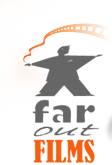“BLACK
TAPE” PRESSROOM
59. MOSTRA INTERNAZIONALE D’ARTE CINEMATOGRAFICA
LA BIENNALE DI VENEZIA
FROM THE CATALOGUE, 2002
TECHNO-GRAFFITI AND LIVE CINEMA: THE LANGUAGE OF IMAGES BETWEEN
THE EPIC, THE REAL AND VOYEURISM.
By Serafino Murri
Cinema is moving a lot faster than its twenty-four (or twenty-five)
frames per second. The desire for novelty that has pushed the
market towards the commercial accessibility of software and hardware
innovations has broken in record time – months rather than
years – the supremacy of exclusives and technological copyright
that had previously kept cinematographic general practice under
the yoke of huge investments and specialist techniques. Private
experience on film becomes voyeuristically universal as history
in action, whereas life, rewritten in the language of film, combines
amateur immediacy with the precision of electronic expression,
which controls and modifies the images on home-made computers.
In the glorious days of Brakhage, Warhol and amateur films, the
transgressive impulse of the underground as an avant-garde alternative
to the mainstream consisted of inoculating the lexicon of the
private dimension in film as mass media: bringing (its own) life
to film. Now the process seems to have been inverted: the private
dimension engulfs cinema in the lexicon of epic writing about
daily reality, it steals from and rewrites the narrative rules
with ‘dirty’, private and slangy accents.
Craftmanship and technical perfection form an alliance, an expressive
whole whose imaginative and radical solutions often overrule the
“professional” ones as a result.
The film demonstrating this is BLACK TAPE – The Videotape
Fariborz Kamkari Found in the Garbage, by Fariborz Kamkari, possibly
the most extreme film of this section, in which the imitation
of life is based on social declaration in a clever play of mirrors.
Experimentation often reaches its peak in advertising and music,
froms that are now impossible to consider ‘low’ or
‘commercial’ forms of directing compared to the ‘pure’
cinematic form. For this reason, ample space has been given to
brief languages – shorts, adverts and videos: as in two
tributes, one to the work of the Anglo-American animators Stephen
and Timothy Quay, the other to the short works byt the eclectic
Hong Kong maestro Wong Kar-Wai.
Observing the intermingling of languages, countries, norms and
customs that unite many of these works in lots having an analogous
thematic tension, the old game of the ‘red tape’,
responds to the necessity for reflecting on common threads and
feelings within the diversity of techniques and languages.
Furthermore, by including a perfomance of “live cinema”
for the first time at the Festival, a material cinema consisting
of music and images manipulated under the eyes of the audience,
a different status has also been considred for the viewer.
Filmmakers such as Jurgen Reble, Shu Lea Chang and Yann Beauvais,
and musicians such as Thomas Koner, explore the limits between
making a film and perceiving it, and incorporate being spectators
in the creative moment. The realistic register, even in the documentary,
becomes a hyper-realistic mannerism, the camera becomes a diary,
a note book of images that manages to comprehend life with the
minimum of premeditation, reacting to the stimulus of the real.
What benefits from this is the recording of realities more difficult
to penetrate beyond their TV image: from Iran to Uruguay, from
the Afghan rubble to Palestine and South Africa, in the work by
young filmmakers or militant intellectuals, there are many documents
that open onto other worlds or other ways of experiencing the
conflicts of the human condition.
*At 12.58 on Saturday May 11 2002, an hour after the police had
combed the roads of the area destined for refugees, I found this
film in the garbage (….) If everybody used a video camera
for recording their lives like a diary….cinema would become
a language with which people could exchange ideas, and get to
know each other by watching their personal films….Wow! Can
you imagine how many films there’d be? And how many weird
and believable stories? Can you imagine how much life would improve?
FARIBORZ KAMKARI
(Venice Catalogue)






